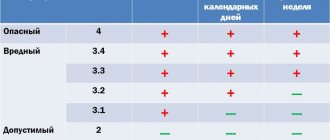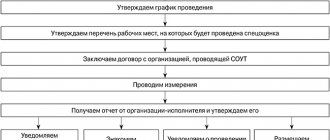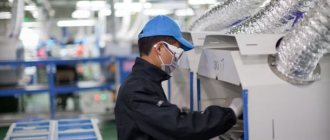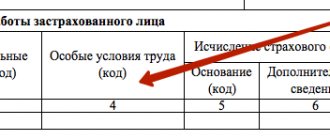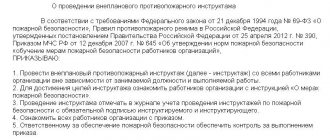What are hygienic standards for working conditions?
Hygiene standards for working conditions are generally accepted indicators from government regulations. If during a work shift the employee is not influenced by harmful factors, then this does not pose a health hazard.
If the opposite happens, a person accumulates substances in the body that can harm health. This happens over the course of a work shift, week, month and year. It turns out that he may have an occupational disease.
The cause of the latter will need to be established. Working conditions are divided into four classes, in turn the third class is divided into subclasses. This is regulated at the legislative level.
The inspection is carried out on a commission by expert organizations together with the management team of the enterprise. In other words, a special assessment of the conditions of the labor process should be carried out for compliance with regulatory parameters.
Hazardous production facilities
The Government has established a Register in which hazardous (in terms of working conditions) production facilities are registered. An activity is considered a source of danger if it includes two signs: the likelihood of causing harm to others, the lack of full control on the part of a person.
Dangerous objects themselves serve as a source of possible danger, both for others and for workers. Most often, this includes industrial organizations that use high-voltage electricity and nuclear energy. This includes construction, vehicle operation and some other areas of activity.
What are optimal working conditions?
If a person works and such conditions do not pose any danger to life and health, then they are called optimal.
To make sure of this, you need to check the following:
- Check vibration level.
- Measure show electromagnetic radiation.
- Assess the impact of harmful factors.
- Measure gas and dust levels in the air.
- Assess the level of noise and illumination using special instruments.
- Conduct a risk assessment from exposure to devices or technical devices installed at the employee’s workplace.
- Other measurements may be made depending on technology and production and the presence of other hazards or equipment.
If after taking measurements according to the established parameters there were no deviations, it can be stated that it is safe to work in this place and this class of conditions belongs to the optimal, that is, the first.
Occupational diseases
Hygienic standards for working conditions provide reliable protection for every worker, because in many enterprises the hazards are very high, and this can provoke the development of an occupational disease. An occupational disease is a pathology caused by exposure to a harmful environment in the workplace. The acute form of the disease is a type that occurs after one exposure to harmful occupational factors.
A chronic form of occupational disease occurs after prolonged and repeated exposure to harmful production factors on the human body.
Occupational poisoning is an acute intoxication caused by harmful chemical factors in working conditions.
An acute form of occupational poisoning is an illness provoked after a single exposure to a dangerous chemical component on any employee. Acute forms of poisoning can occur due to accidents, serious violations in technological processes, safety and sanitation at work, in situations where the concentration of toxic substances significantly exceeds the established norm.
The chronic form of poisoning develops after prolonged constant exposure to small concentrations of a harmful substance.
How to create optimal conditions for an employee? What is meant by hygienic standards of working conditions that are ideal for every working employee of a small or large manufacturing enterprise?
What are acceptable working conditions?
Specialists from an expert organization are invited to carry out instrumental measurements, that is, an agreement is concluded with experts to conduct a special assessment. The following work is carried out:
- The level of noise, dust, gas contamination and other parameters is checked in accordance with production technology.
- Equipment performance is assessed.
- Laboratory tests are being carried out.
- Based on the tests performed, the results obtained are compared with the standard ones.
The regulations specified in the standards show that the results obtained do not exceed acceptable values, that is, there is no negative impact.
This class of working process conditions is considered acceptable, that is, human activity is associated with harmful substances and indicators, but the substances and other indicators determined by measurements do not exceed the maximum permissible concentration or maximum permissible limit. This is the second class of danger.
Terminology of assessment indicators
When analyzing indicators of production conditions, special terms are used. Here is their abbreviation and explanation:
Additional facts
As a rule, when hiring an applicant, it is necessary to fill out the “Working Conditions” column in the employment contract. It would seem that nothing could be simpler. However, many organizations are often subject to numerous unscheduled inspections, and therefore there is no special assessment of working conditions. What to do in this case? Of course, it is worth continuing to hire employees. In this case, it is necessary to take into account some features. For example, before conducting a special assessment of working conditions, the employer should not include any guarantees or compensation for harm in the employment contract. It is best to mark these points when the testing and evaluation is completed. Such actions are legally justified and legal.
- GN – hygiene standards;
- MPC – maximum permissible concentrations of harmful substances;
- OBUV – approximate safe exposure levels;
- MPL – maximum permissible level;
- SDA – maximum permissible doses. MAC and MAC are quantitative indicators of MAC, when exposed to a person for 8 hours a day no more than 5 times a week during his working experience, there is no deterioration in health and no prof. illness;
- DN – permissible loads.
Degrees of harm
Working conditions are divided into degrees of harmfulness:
- Class 1 - these are optimal conditions . That is, the impact of harmful factors on a person is completely eliminated, and his health is safe.
- Class 2 - acceptable . There is exposure to harmful factors during the working day, but everything is within normal limits.
- Class 3 - harmful . These are conditions under which an employee is affected by negative indicators and, after tests, their level is more than normative.
- Class 4 - dangerous . The employee is affected by factors that clearly cannot have a positive effect on his health. The consequences may cause the risk of developing diseases. Such jobs must be eliminated, as it is not allowed to work in them.
4 classes of harmful working conditions
The third class of conditions has four subclasses, namely:
- 3.1 - when exposed to harmful substances during a shift, a person’s health quickly recovers before the start of the next shift. That is, the impact stops and the body’s recovery begins.
- 3.2.- when exposed to such a level of dangers and hazards, permanent changes begin in the body, which can ultimately lead to the development of an occupational disease. It may take about ten to fifteen years for this to manifest itself, but it all depends on the condition of the person as a whole.
- 3.3 - when exposed to harmful factors, there is a deterioration in health, which can lead to mild or moderate occupational disease. The period of disability can last a long time.
- 3.4 - working in workplaces with this hazard class, an employee can get a persistent occupational disease, while persistent loss of ability to work accompanies him.
Depending on the hazard class established by the commission, the percentage of additional payments for hazards is determined. This compensates for the loss of health.
How the sanitary and hygienic characteristics are compiled
The order of the Federal Service for Surveillance in the Sphere of Consumer Rights Protection and Human Welfare of 2008 approved instructions on the procedure for collecting information and drawing up sanitary and hygienic characteristics of a person’s working conditions if symptoms of an occupational disease are detected. As already noted, the document is drawn up by the territorial divisions of Rospotrebnadzor of the constituent entities of the Russian Federation within two weeks from the receipt of notification of an acute or chronic pathology of a citizen.
To formalize the sanitary and hygienic characteristics of the employee’s working conditions, the management has the right to request additional papers or a conclusion from the sanitary and epidemiological station at the previous place of work. After a medical diagnostic diagnosis is made, the citizen is given a referral to undergo MSEC. If it is impossible to establish data on harmful working conditions due to the liquidation of the enterprise, other documents are used that confirm the impact of harmful production factors during the period of professional activity and performance of official duties. They can be an extract from the employee’s work book, certified by a notary, training logs, extracts from literary reference materials containing information about the sanitary and hygienic characteristics of working conditions in similar industries.
To prove that the cause of the disease was precisely dangerous and non-compliant working conditions, the employer’s testimony is also taken into account. Any sample of sanitary and hygienic characteristics of working conditions contains information about:
- harmful factors of the production industry;
- workflow mode;
- concentration and level of toxic substances in the atmosphere.
If it is impossible to obtain conclusions on laboratory and instrumental studies from independent experts, Rospotrebnadzor entrusts the research to its subordinate institution - the Center for Hygiene and Epidemiology of Rospotrebnadzor. The results of physical, chemical or biological research are applied to the sanitary and hygienic characteristics of the employee’s working conditions.
The document must indicate personal protective equipment that is used by a person in the process of carrying out professional activities, the presence of previous conclusions and recommendations of the sanitary and epidemiological station. Drawing up sanitary and hygienic characteristics of working conditions cannot be done without the testimony of the victim himself, his colleagues, and the employer. Testimony is drawn up on separate sheets indicating the passport details of each witness.
Harmful factors
Harmful factors come in different directions, these include:
- Chemical and biological substances . When exposed to the body in the maximum permissible concentration, they do not have a harmful effect, but if the concentration of these substances is at a level that exceeds the limit, then the body has a negative effect.
- Noise . If the limit exceeds 80 dB, then your health is at risk.
- Electromagnetic radiation . When exposed to humans, it can cause radiation sickness, so you should carefully consider this issue. Check the grounding device and other mandatory measures.
- Dust in the air shows that a person's lungs are under a lot of stress and after this the soft tissues become rough.
Other unfavorable working conditions
In any sample of sanitary and hygienic characteristics of working conditions, an indicator is indicated that reflects the force load on the body and its individual systems (musculoskeletal system, cardiovascular, respiratory activity). It is called the severity of labor. To determine the severity of work, the values of dynamic load, the mass of lifted and moved loads, the total number of working monotonous movements, the time during which the worker’s body is in a statically immobilized position and other nuances are taken into account.
Unsatisfactory sanitary and hygienic factors of working conditions also include tension that arises during the performance of professional duties. In this case, the increased load is reflected in the central nervous system, sensory organs, sensory, and psycho-emotional background of workers.
Class assignment
Expert organizations that operate accredited laboratories can classify labor as hazardous. This procedure is performed during a special assessment of working conditions.
Attribution algorithm:
- Measurements are taken, and the instruments used in the work must be verified and the laboratory assistants certified.
- After measurements are taken, analyzes are carried out.
- Based on the tests carried out, it is established how many times the maximum permissible concentration exceeds the standard value.
- The obtained data is entered into the protocol, and then into the certification card.
- Based on the results obtained, the percentage of additional payment to employees is established.
At-risk groups
If workers are exposed to harmful influences during their shift, they can be classified as high-risk. That is, hygiene standards are exceeded. Working in such conditions contributes to the development of occupational diseases.
Lists of professions No. 1 and No. 2 have been adopted, which include workers associated with metallurgical production.
Employees working in extreme conditions include persons whose health condition may suddenly deteriorate.
Sanitary standards
Content
Introduction
1. Sanitary standards for working conditions
2. Harmful production factors
3. The concept of maximum permissible concentrations
4. Characteristics of harmful production factors: noise, vibration
5. Requirements and standards for heating and ventilation
Conclusion
Bibliography
Introduction
The “Legislation of the Russian Federation on labor protection” states that state policy in the field of labor protection provides for joint actions of the legislative and executive authorities of the Russian Federation and the republics included in the federation, associations of employers, trade unions represented by their relevant bodies and other representative bodies authorized by employees to improve working conditions and safety, prevent industrial injuries and occupational diseases and is based on such principles as:
— priority of the life and health of the employee in relation to the results of the enterprise’s production activities;
— coordination of activities in the field of labor protection with other areas of economic and social policy, with activities in the field of labor protection and the environment;
— establishment of uniform requirements in the field of labor protection of all enterprises, regardless of the form of ownership and management;
— stimulating the development and implementation of safe equipment, technology and means of protecting workers;
— state participation in financing labor protection;
— implementation of a tax policy that promotes the creation of healthy and safe working conditions at the enterprise, etc.
Issues of occupational safety and health are dealt with by various research institutes of occupational safety, the Institute of Occupational Hygiene and Occupational Diseases of the Ministry of Health of the Russian Federation, industry institutes and laboratories on occupational safety, central and local bodies of the scientific organization of labor.
1. Sanitary standards for working conditions
Professional activity is characterized by the following main factors: the volume and nature of the load, especially the ratio of physical and neuro-emotional stress; body position (working posture) during work, the volume and nature of their movements, work mode - alternating periods of work and rest during a work shift, week, as well as environmental conditions, including work in urban environments or in agriculture.
The State Committee for Sanitary and Epidemiological Surveillance of the Russian Federation approved for the first time the Sanitary Rules and Standards “Hygienic Requirements for Working Conditions for Women. SanPiN 2.2.555-96”, which defines mandatory hygienic requirements for production processes, equipment, main workplaces, the labor process, the production environment and sanitary provision for working women in order to protect their health.
The purpose of the document is to prevent the negative consequences of the use of women’s labor in production conditions, taking into account the anatomical and physiological characteristics of their body, to preserve the health of working women based on a comprehensive hygienic assessment of factors in the working environment and the labor process.
When organizing any labor process, it is necessary to take into account the psychological and physiological characteristics of a person, to know the limits of his muscle strength and speed of movement, speed of reaction and attention, speed of information processing and its accuracy, etc. In this case, it is necessary to take into account how these qualities change during the working day, what requirements can be made of a person and what conditions need to be created in order for these requirements to be met.
Sanitary and hygienic conditions at an enterprise have a great impact on human health and labor processes. These include: temperature conditions, humidity and air speed, cleanliness of air, premises, equipment and inventory, personal hygiene of workers, etc.
Standard temperature, humidity and air purity in rooms are maintained using ventilation, heating and air conditioning. At the same time, effective measures to combat air pollution are wet cleaning of premises, cleanliness and order in the workplace, etc. In enterprises with significant dust emissions, it is necessary to provide for cleaning the premises using vacuum cleaners or by hydro-washing.
All commercial and industrial premises must be kept properly clean. You should wet sweep and wash floors daily, remove dust and cobwebs, and wipe windows, doors, and panels. At the end of work, the premises must be thoroughly cleaned and left overnight in complete sanitary order. Once a week, the premises are cleaned using a soapy alkaline solution and bleach, and once a month a sanitary day is scheduled for general cleaning and disinfection. Equipment (counters, tables for packaging, cutting boards, etc.) and inventory are cleaned every day after work, washed with hot water using detergents approved by the sanitary and epidemiological service.
Whitewashing of retail, warehouse and other premises should be carried out regularly as they become dirty. Planned general repairs are carried out as needed.
Disinfection and disinsection of premises are carried out systematically and as directed by the sanitary and epidemiological service.
The enterprise must be provided with a sufficient amount of cleaning equipment (buckets, basins, brushes, brooms, rags, etc.) and detergents (soap, soda, lye, etc.), which must be stored in cabinets specially designated for these purposes in containers with appropriate inscriptions. At least once a week, cleaning equipment should be disinfected with a 10% bleach solution.
A person’s health is influenced not only by the general sanitary conditions in which he has to work, but also by compliance with the rules of personal hygiene, which consist of daily care for the cleanliness of the body, linen, clothes and shoes, in observing the correct alternation of work, rest and sleep, took physical culture that strengthens the body.
Premises for personal hygiene of women are provided at public catering establishments when the number of women working in the largest shift is 100 or more, and at food retail establishments with a retail area of 650 m2 or more, and for non-food products - with a retail area of 1500 m2 or more. If catering establishments employ from 50 to 100 women on the largest shift, an individual cabin for procedures in the restroom is equipped.
Persons whose work is related to food products undergo a medical examination once every three months, examinations for tuberculosis - annually, and for bacterial and helminth carriage - within the time limits established by the local sanitary and epidemiological service. Each employee subject to examination is required to have a personal health book in the established form, in which the results of medical examinations are recorded.
2. Harmful production factors
Dangerous and harmful production factors, according to the nature of their action, are divided into: physical, chemical, biological and psychophysiological.
Chemical hazards and harmful production factors vary:
- by the nature of the effect on the human body (toxic, irritating, sensitizing, carcinogenic, mutagenic, affecting reproductive function);
— along the route of penetration into the human body (through the respiratory system, gastrointestinal tract, skin and mucous membranes);
- biological - bacteria, viruses.
Psychophysiological dangerous and harmful production factors, according to the nature of their action, are divided into physical and neuropsychological overloads.
Harmful production factors cannot be considered as a permanent phenomenon inherent in this profession. They can be weakened or eliminated altogether when the technological process is improved and working conditions are improved.
If the technological process forces a worker to remain in the same position for a long time (standing, sitting, inclined, etc.) or leads to overstrain of individual systems and organs of the body, this also represents a harmful production factor. For example, prolonged standing work is associated with strong static stress, which can lead to deformation of bones and joints, as well as vascular changes (dilation of the veins of the lower extremities).
Such diseases occur among sellers, cooks, loaders, waiters, etc. Therefore, preventive measures in the field of trade and catering and production conditions should be aimed at easing the load on the musculoskeletal system, strengthening it and allowing the human body to move freely from one place to another. positions to another. Thus, sellers are recommended to sit for 5-10 minutes every 2 hours, for which purpose folding seats should be equipped at their workplaces. It is also advisable to wear shoes with some orthopedic elements (recess under the heel, lining of the free arch), which protect the table from the appearance of flat feet, and also reduce foot fatigue. At the initial stage of varicose veins, you should use therapeutic elastic stockings.
Unfavorable working environment factors also include drafts, high air humidity, water vapor generated during cooking and washing dishes, flour dust, thermal decomposition products of fat that occur during frying and baking confectionery products.
If heating devices operating on solid or gaseous fuels are used incorrectly, the air environment can become polluted by waste gases - products of fuel combustion.
Poisonous (toxic) substances disrupt the normal functioning of the body and lead to temporary and chronic changes in it. Based on their physiological effects, they are divided into 5 groups:
- irritants - affect the mucous membrane of the respiratory tract (ammonia, chlorine, sulfur dioxide and sulfuric anhydride, etc.);
- suffocating - their action is associated with disruption of the gas exchange process. This group includes inert gases (reducing the oxygen content in the air below the norm necessary for normal tissue respiration), as well as chemical asphyxiants (carbon monoxide, hydrogen sulfide, etc.), which cause not only suffocation, but also poisoning;
- volatile drugs (and the like) - have a narcotic effect without serious damage to internal organs (saturated hydrocarbons, ethers, freons, etc.);
- somatic poisons - cause damage to internal organs, as well as the hematopoietic and nervous systems (arsenic, sulfur, tin, methyl alcohol, gasoline, naphthalene);
- toxic dust, causing fibrosis (silicon, asbestos, etc.), and non-toxic, irritating the skin, eyes, gums, ears.
3. The concept of maximum permissible concentrations
The maximum permissible concentration (MAC) of harmful substances is the maximum concentration of a harmful substance that, over a certain period of exposure, does not affect human health and his offspring, as well as components of the ecosystem and the natural community as a whole.
To control their content in the air, well-defined standardized environmental standards are needed, which is why the concept of maximum permissible concentration was introduced. MPC values for air are measured in mg/m3. (Table 1).
Table 1
| MAXIMUM ALLOWABLE CONCENTRATIONS some gaseous substances in the atmospheric air and air of industrial premises | ||
| Substance | MPC in atmospheric air, mg/m3 | Maximum permissible concentration in the air prod. premises, mg/m3 |
| Nitrogen dioxide | Maximum one-time 0.085 Average daily 0.04 | 2,0 |
| Sulfur dioxide | Maximum one-time 0.5 Average daily 0.05 | 10,0 |
| Carbon monoxide | Maximum one-time 5.0 Average daily 3.0 | During the working day 20.0 Within 60 minutes* 50.0 Within 30 minutes* 100.0 Within 15 minutes* 200.0 |
| Hydrogen fluoride | Maximum one-time 0.02 Average daily 0.005 | 0,05 |
| * Repeated work in conditions of high CO content in the air of the working area can be carried out with a break of at least 2 hours | ||
MPCs have been developed not only for air, but also for food products, water (drinking water, reservoir water, wastewater), and soil.
The maximum concentration for a work area is considered to be such a concentration of a harmful substance that, during daily work throughout the entire working period, cannot cause illness during work or in the long-term life of the present and subsequent generations.
Ambient air concentration limits are measured in populated areas and refer to a specific time period. For air, there is a maximum single dose and an average daily dose.
Depending on the MPC value, chemicals in the air are classified according to the degree of danger. For extremely hazardous substances (mercury vapor, hydrogen sulfide, chlorine), the maximum permissible concentration in the air of the working area should not exceed 0.1 mg/m3. If the maximum permissible concentration is more than 10 mg/m3, then the substance is considered low-hazard.
The country has developed and approved maximum permissible concentrations (MPC) of toxic and harmful substances in the air of industrial premises.
According to the degree of impact on the human body, harmful substances are divided into 4 classes: 1 - extremely dangerous; 2 - highly dangerous; 3 - moderately dangerous; 4 - low risk (Table 2).
Table 2 Maximum permissible concentrations of some harmful substances typical for public catering and retail establishments
| Harmful substances | MPC, | Hazard Class |
| Acrolein | 0.7 | 2 |
| Ammonia | 20 | 4 |
| Mineral oils | 300 | 4 |
| Carbon monoxide | 20 | 4 |
| Sulfuric acid | 1 | 2 |
MPCs are established for the average person, however, people weakened by illness and other factors may feel uncomfortable at concentrations of harmful substances that are less than MPCs. This, for example, applies to heavy smokers.
The maximum permissible concentrations of certain substances in a number of countries vary significantly. Thus, the maximum permissible concentration of hydrogen sulfide in atmospheric air during 24-hour exposure in Spain is 0.004 mg/m3, and in Hungary – 0.15 mg/m3 (in Russia – 0.008 mg/m3).
In our country, standards for maximum permissible concentrations are developed and approved by the sanitary-epidemiological service and government agencies in the field of environmental protection. Environmental quality standards are uniform for the entire territory of the Russian Federation.
4. Characteristics of harmful production factors: noise, vibration
Noise and vibration in production are created by various mechanisms, machines and other sources.
Noise as a harmful production factor is a set of sounds, different in level and frequency, that arise as a result of an oscillatory process and are not desirable for humans.
Being a general biological irritant, noise not only affects the hearing aid, but can lead to disorders of the cardiovascular and nervous systems and contributes to the occurrence of hypertension. In addition, it is one of the reasons for rapid fatigue of the worker and can cause dizziness, which in turn can lead to an accident. Constant exposure to noise can cause an occupational disease - hearing loss.
A person perceives sound vibrations with a frequency from 16 to 20,000 Hz. Sounds with frequencies below 16 Hz are called infrasounds, and sounds above 20,000 Hz are called ultrasounds. Infrasounds and ultrasounds also affect a person, but he does not hear them.
Noise is characterized by strength (intensity) and volume.
The strength of sound is determined by the sound energy that is transmitted in one second through a unit of surface. The minimum sound intensity perceived by a person is usually called the hearing threshold - this is the conditional zero point of the noise intensity scale in bels (B). One bel (1 B) corresponds to a 10-fold increase in noise intensity. According to this scale, the sound intensity that causes pain in the ears is 13-14 bels (B) or 130-140 decibels (dB).
Loudness is the subjective physiological properties of sounds associated with the individual perception of them by the human hearing organs. In addition to the strength of sound, it depends on the frequency of sound vibrations. With an increase in frequency to 2-3 thousand Hz, the volume of sound at constant intensity increases, and with a further increase in frequency, it decreases.
GOST 12.1.003-83 “SSBT. Noise. General Safety Requirements” establishes a noise classification, permissible noise levels in workplaces, general requirements for the noise characteristics of machines, mechanisms, vehicles and other equipment, as well as for noise protection measures. According to this GOST, the permissible noise level and equivalent noise levels in workplaces are: in control rooms, work rooms (dining rooms) - 60 dBA (decibel on the A scale of the sound level meter), in production premises - 85 dBA.
Vibration - mechanical vibrations of elastic bodies at low frequencies (3-100 Hz) with large amplitudes (0.5-0.003 mm).
Oscillations with a frequency of 6-9 Hz, close to the frequency of human oscillations, are especially harmful.
Vibration's impact on the human body can be general and local (impact on individual parts of the body).
At trade enterprises, public catering establishments, in production workshops and areas, vibration is observed during the operation of refrigeration units, handling and packaging equipment and other machines and mechanisms. The limit values of local (local) vibration are established by GOST “SSBT. Vibration safety. General requirements. 12.1.012-90". To measure vibrations with a frequency of 5-100 Hz and a vibration amplitude of 0.05-5 mm, a VR-1 hand-held vibrograph is used.
The fight against noise and vibration is carried out in the following areas:
— improvement of designs of machines, mechanisms, equipment;
— rational layout of rooms with noisy objects;
— use of special shock-absorbing, noise-absorbing and sound-insulating devices and devices;
— use of personal protective equipment.
5. Requirements and standards for heating and ventilation
Heating and ventilation contribute to the creation of an indoor air environment that complies with occupational hygiene standards, the requirements of SNiP 11-33-75 “Heating, ventilation and air conditioning”, SN 245-71 “Sanitary standards for the design of industrial enterprises”, GOST 12.1.006- 76 “Working area air” and 12.4.021-75 “Ventilation systems. General requirements".
Heating systems are divided into water, steam, air and combined. Water heating systems are widespread, they are efficient and convenient. In these systems, radiators and pipes are used as heating devices. The air cooling system means that the supplied air is preheated in heaters.
During the cold period, it is necessary to provide heat supply by heating systems to all rooms with permanent or long-term (over 2 hours) occupancy, as well as to rooms in which, due to technological conditions, it is necessary to maintain a positive temperature. The placement of heating devices should provide protection for workers from falling shackles of cold air when workplaces are located at a distance of 2 m or less from windows in the external walls. The source of additional heat entering the premises is the sun's rays and the artificial lighting system.
In workplaces where operations involving constant contact with wet and cold objects (cutting frozen meat, fish) are carried out, hand warming devices should be equipped.
The presence of a sufficient amount of oxygen in the air is a necessary condition for ensuring the vital functions of the body. A decrease in oxygen content in the air can lead to oxygen starvation - hypoxia, the main symptoms of which are headache, dizziness, slow reaction, disruption of the normal functioning of the organs of hearing and vision, and metabolic disorders.
To organize the technological process at enterprises, various machines and equipment are widely used, which during operation emit harmful gases that pollute the atmosphere. Dust is generated during unpacking, packing, packing and other operations with goods. The constant presence of a significant number of visitors at various retail establishments also requires more intensive air exchange. For this purpose, natural or artificial ventilation is used.
Natural ventilation provides air exchange in rooms as a result of the action of wind and heat pressures formed due to different air densities outside and inside the premises. It is used in rooms where no harmful or unpleasant-smelling substances are emitted.
Natural ventilation is divided into organized and unorganized.
Organized natural ventilation is carried out by aeration or deflectors. Aeration involves air circulation through ventilation ducts, wall lights and special air ducts; ductless air exchange through windows, vents, transoms, folding wall surfaces, etc. is also possible. With deflector ventilation, air exchange occurs through channels and air ducts with special nozzles. Their action is based on the fact that when the wind flows around the nozzle, a higher pressure is created on the windward side than on the opposite side, as a result of which air exchange occurs.
Unorganized ventilation occurs through leaks in structures (windows, doors, walls). It is caused by the difference in air temperatures indoors and outdoors, as well as by the movement of air in the wind.
Artificial ventilation (mechanical) is achieved through the operation of fans or ejectors. It can be supply (pressure), exhaust (suction) and supply and exhaust.
With supply ventilation, air is supplied by a ventilation unit, and air is removed through lanterns or deflectors. It is used, as a rule, in rooms with excess heat and low concentrations of harmful substances.
Exhaust ventilation involves pumping air out of rooms using a ventilation unit. This system is used for ventilation of rooms with a high concentration of harmful substances, moisture and heat.
Supply and exhaust ventilation is carried out using separate ventilation systems, which must provide the same amount of air supplied and removed from the room. In rooms where harmful substances are constantly released, exhaust ventilation should exceed the pressure ventilation by approximately 20%. In these cases, air is extracted from places where harmful substances accumulate and clean air is supplied to the workplace.
By purpose, general ventilation and local ventilation are distinguished.
General ventilation provides air exchange for the entire room, local ventilation for individual workplaces. Ventilation must be arranged in such a way that the flow of polluted air does not pass through the breathing zone of people in the workplace.
In certain rooms where there is a danger of a large amount of harmful substances breaking through in a short time, additional emergency ventilation is provided using high-capacity axial fans.
Providing the necessary indoor air parameters depends on the frequency of air exchange, the power of ventilation systems and the choice of their type.
Air conditioning is the creation and maintenance of certain parameters of the air environment in enclosed spaces - temperature, humidity, cleanliness, composition, air speed and air pressure. Air parameters must be stable and most favorable for humans. Air conditioning is achieved by a system of technical means used to move and distribute air and automatically regulate its parameters.
Modern automatic air conditioners clean the air, heat or cool it, humidify or dry it depending on the time of year and other conditions, subject it to ionization and ozonation, and also supply it to the premises at a certain speed.
The main elements of air conditioning systems are air heaters, filters, refrigeration machines, humidifiers, thermostats and other devices that regulate the operation of air conditioning units. Air conditioning units are local (for individual rooms) and central (for all rooms of the building).
Air conditioning is increasingly used in public buildings, medical institutions, industrial and commercial enterprises, and residential premises.
Conclusion
The problems of ensuring human life safety are becoming more acute. The number of accidents in industry, transport and agriculture is not decreasing; industrial and household injuries will increase.
Man and the environment interact and develop only in conditions where the flows of energy, matter and information are within limits that are favorably perceived by man and the natural environment.
Human interaction with the environment can be positive or negative; the nature of the interaction is determined by the flow of substances, energies and information. Any excess of the usual flow levels is accompanied by negative impacts on humans or the natural environment. In the technosphere, negative impacts are caused by elements of the technosphere (machines, structures, etc.) and human actions. By measuring the magnitude of any flow from the minimum significant to the maximum possible, it is possible to go through a number of characteristic states of interaction in the “man-environment” system.
Public catering, along with retail trade, fulfills the main socio-economic task of the development of our society - satisfying the material and cultural standard of living of the population.
A public catering enterprise is an enterprise intended for the production of culinary products, flour confectionery and bakery products, their sale and (or) organization of consumption.
Food enterprises play an important role in creating material conditions that increase the well-being of the state. Therefore, it is necessary to improve the quality of design of industrial enterprises and carry out construction according to more progressive economic projects.
Bibliography
1. Senatov I. G. “Sanitary equipment in public catering.” M.: Economics, 1973.
2. Reference manual for SNiP. "Design of public catering establishments." M.: Stroyizdat, 1992.
3. Federal Law of March 30, 1999 No. 52-FZ “On the sanitary and epidemiological welfare of the population”
4. SanPiN 42-123-5777-91 “Sanitary rules for public catering establishments”
5. Labor protection in trade, catering, food production and small business and everyday life: Textbook. Guide for beginners and Wednesday Prof. Education / D.F. Fatykhov, A.N. Belekhov. – 4th ed., erased. – M.: Publishing House, 2003.
6. Filyev V.I. Labor protection at enterprises of the Russian Federation. M., 1997.
7. “Sanitary rules for public catering establishments, including confectionery shops and enterprises producing soft ice cream.” Ministry of Health of the USSR. SanPiN 42-123-5777-91. M., 1991.
8. Life safety. L.V. Bondarenko, A.E. Aleevsky, G.A. Kolupaev, S.M. Serbin. Moscow 1999.
9. Ivanov B.S. Man and habitat: Textbook, M.: MGIU, - 1999.
Hygienic assessment of work
Based on the developed methods and other regulations, a hygienic assessment of working conditions is carried out. The main goals of the event are:
- Ensuring control over the state of health and safety based on accepted standards. Enterprises are developing a production control program. Depending on the class of harmful substances, the frequency of measurements is established. The latter can be performed by employees who have certificates. Audits are carried out by employees from other higher organizations, such as Rospotrebnadzor and expert companies.
- Determining which activities need to be carried out first, including assessing the effectiveness of completed tasks.
- Creation of a data bank on the conditions of the labor process at enterprises.
- Analyzing the health status of employees, conducting special examinations and establishing diagnoses. Organizations are required to conduct medical examinations annually, that is, if deviations in health status are detected, the presence of occupational diseases is determined.
- Conducting an occupational risk assessment if an employee performs production tasks in hazardous conditions.
If any regulatory indicators are violated, the responsibility of the facility manager is to urgently take measures to eliminate such cases. Excesses of hazardous factors must be eliminated, if possible, or reduced to a minimum level.
Thermal irradiation
The normal temperature of the human body is 36.6 degrees. To ensure that it is constantly preserved, there are two types of analyzers on the human skin: some react to heat, and others to cold. These receptors protect a person from overheating or hypothermia and help maintain a constant temperature balance. If the thermal regime at an enterprise is constantly violated, the employee begins to get sick, becoming hypothermic or overheating.
By observing hygienic standards and classes of working conditions, even in the most hazardous enterprise, you can minimize the aggressive impact on the human body. Each employee working in such production must undergo regular examinations and visit sanatoriums in order to remove from the body everything that accumulates in the body over time.
But the entire responsibility for creating suitable working conditions that meet standard indicators falls on the shoulders of the employer. Every employee has the right to file a complaint with higher authorities if he believes that his rights are being violated.
